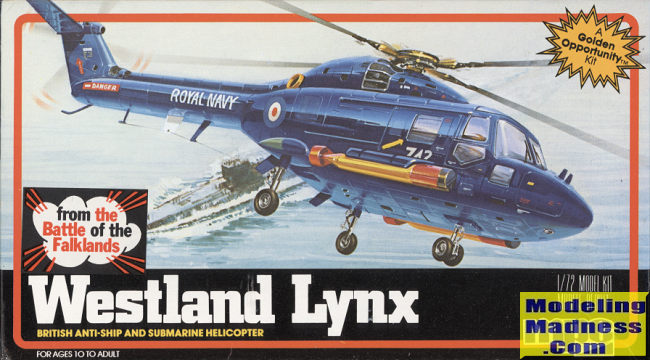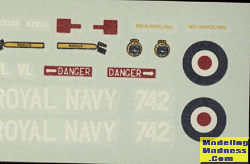
MPC 1/72 Westland Lynx
| KIT #: | 4205 |
| PRICE: | $3.50 when new |
| DECALS: | One option |
| REVIEWER: | Scott Van Aken |
| NOTES: | Reboxed Airfix kit. |

| HISTORY |
The Westland Lynx is a British multi-purpose twin-engined military helicopter designed and built by Westland Helicopters at its factory in Yeovil. Originally intended as a utility craft for both civil and naval usage, military interest led to the development of both battlefield and naval variants. The Lynx went into operational usage in 1977 and was later adopted by the armed forces of over a dozen nations, primarily serving in the battlefield utility, anti-armour, search and rescue and anti-submarine warfare roles.
The Lynx is a fully aerobatic helicopter with the ability to perform loops and rolls. In 1986, a specially modified Lynx set the current Fédération Aéronautique Internationale's official airspeed record for helicopters (category excludes compound helicopters) at 400.87 km/h (249.09 mph), which remains unbroken as of January 2022.
Several land and naval variants of the Lynx have been produced along with some major derivatives. The Westland 30 was produced as a civil utility helicopter; it was not a commercial success and only a small number were built during the 1980s. In the 21st century, a modernised variant of the Lynx was designed as a multi-role combat helicopter, designated as the AgustaWestland AW159 Wildcat; the Wildcat is intended to replace existing Lynx helicopters.
| THE KIT |
 closed. Next
are torpedoes and the main gear/sponsons. Lastly is the rotor assembly and the
nose. If you forgot weight under the cockpit floor, you can add some in the
nose.
closed. Next
are torpedoes and the main gear/sponsons. Lastly is the rotor assembly and the
nose. If you forgot weight under the cockpit floor, you can add some in the
nose.
| CONCLUSIONS |
It has been a while since this kit was last released. The most recent has been the Mk.8 boxing with a new sprue. I've built the HAS.2 twice; once as a Dutch plane using Modeldecals and once as a HAS.3 using a SAM decal sheet for a Falklands plane. Both times I liked the end result and found the build experience to be a good one. This is old school raised panel lines, but if you can get past that, you'll find it to be a nice kit.
| REFERENCES |
https://en.wikipedia.org/wiki/Westland_Lynx
October 2022
Copyright ModelingMadness.com. All rights reserved. No reproduction in part or in whole without express permission from the editor.
If you would like your product reviewed fairly and fairly quickly, please contact the editor or see other details in the Note to Contributors.